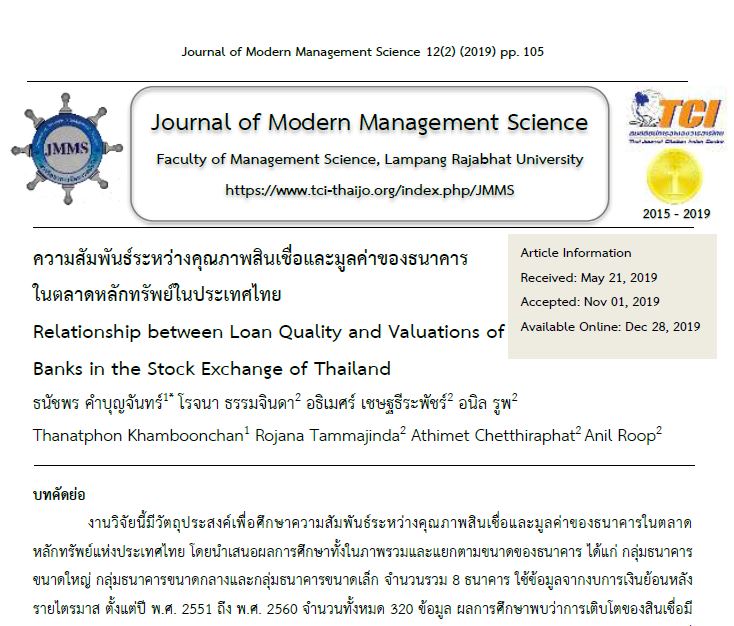ความสัมพันธ์ระหว่างคุณภาพสินเชื่อและมูลค่าของธนาคาร ในตลาดหลักทรัพย์ในประเทศไทย
Main Article Content
บทคัดย่อ
งานวิจัยนี้มีวัตถุประสงค์เพื่อศึกษาความสัมพันธ์ระหว่างคุณภาพสินเชื่อและมูลค่าของธนาคารในตลาดหลักทรัพย์แห่งประเทศไทย โดยนำเสนอผลการศึกษาทั้งในภาพรวมและแยกตามขนาดของธนาคาร ได้แก่ กลุ่มธนาคารขนาดใหญ่ กลุ่มธนาคารขนาดกลางและกลุ่มธนาคารขนาดเล็ก จำนวนรวม 8 ธนาคาร ใช้ข้อมูลจากงบการเงินย้อนหลังรายไตรมาส ตั้งแต่ปี พ.ศ. 2551 ถึง พ.ศ. 2560 จำนวนทั้งหมด 320 ข้อมูล ผลการศึกษาพบว่าการเติบโตของสินเชื่อมีความสัมพันธ์ในทิศทางตรงกันข้ามกับมูลค่าของธนาคารในตลาดหลักทรัพย์แห่งประเทศไทยอย่างมีนัยสำคัญทางสถิติที่ระดับ 0.05 โดยมีค่าสัมประสิทธ์สหสัมพันธ์ เท่ากับ -0.000000000113 อย่างไรก็ตาม พบว่าสินเชื่อไม่ก่อให้เกิดรายได้ไม่มีความสัมพันธ์กับมูลค่าของธนาคารในตลาดหลักทรัพย์แห่งประเทศไทย สำหรับการวิเคราะห์ตามขนาดของธนาคารพบว่า การเติบโตของสินเชื่อมีความสัมพันธ์ในทิศทางตรงกันข้ามกับมูลค่าของธนาคารขนาดใหญ่และธนาคารขนาดกลาง แต่ไม่มีความสัมพันธ์กับมูลค่าของธนาคารขนาดเล็ก ส่วนสินเชื่อที่ไม่ก่อให้เกิดรายได้มีความสัมพันธ์ในทิศทางเดียวกันกับมูลค่าของธนาคารขนาดใหญ่ แต่สินเชื่อที่ไม่ก่อให้เกิดรายได้มีความสัมพันธ์ในทิศทางตรงกันข้ามกับมูลค่าของธนาคารขนาดกลาง แต่ไม่มีความสัมพันธ์กับมูลค่าของธนาคารขนาดเล็ก ผลการวิเคราะห์การถดถอยพหุคูณมีเทอมปฏิสัมพันธ์พบว่าอิทธิพลของตัวแปรการเติบโตของสินเชื่อส่งผลกระทบในทิศทางตรงกันข้ามกับสินเชื่อที่ไม่ก่อให้เกิดรายได้ต่อมูลค่าของธนาคารในตลาดหลักทรัพย์แห่งประเทศไทย
Article Details
บทความจะต้องผ่านการพิจารณายอมรับให้ตีพิมพ์ได้โดยกองบรรณาธิการของวารสารการจัดการ คณะวิทยาการ มหาวิทยาลัยราชภัฎลำปาง และได้รับการตรวจอ่านโดยผู้ทรงคุณวุฒิ(Peer review) และผู้เขียนบทความต้องปรับปรุงตามข้อเสนอแนะหากมีก่อนตีพิมพ์ บทความที่ไม่ผ่านการพิจารณา กองบรรณาธิการจะแจ้งให้ทราบผลการพิจารณา แต่จะไม่ส่งต้นฉบับคืนผู้เขียน
วารสารวิทยาการจัดการสมัยใหม่ คณะวิทยาการจัดการ มหาวิทยาลัยราชภัฏลำปาง ตีพิมพ์เผยแพร่ทั้งฉบับพิมพ์และฉบับออนไลน์ เราอนุญาตให้นำบทความไปใช้ประโยชน์ทางวิชาการได้ ภายใต้ขอบเขตของกฏหมายลิขสิทธิ์
เอกสารอ้างอิง
ธนาคารแห่งประเทศไทย. (2561). ผลดำเนินงานของระบบธนาคารพาณิชย์ปี 2560. (ออนไลน์). 29 พฤศจิกายน 2561 สืบค้นจากhttps://www.bot.or.th/Thai/FinancialInstitutions/Publications/FIProformance_Press/
n5361t.pdf
ศูนย์วิจัยกสิกรไทย. (2550). 10 ปีวิกฤติเศรษฐกิจไทย 2540: บทเรียนของสถาบันการเงินไทย. (ออนไลน์).
29 พฤศจิกายน 2561 สืบค้นจาก www.rcim.rmutr.ac.th
วิกานดา ใจสมุทร. (2558). อิทธิพลของปริมาณหนี้ที่ไม่ก่อให้เกิดรายได้ (NPLs) ต่อความสามารถในการทำกำไรของธนาคารพาณิชย์ที่จดทะเบียนในตลาดหลักทรัพย์แห่งประเทศไทย. (รายงานผลการวิจัย). บัณฑิตวิทยาลัย มหาวิทยาลัยกรุงเทพ
Caprio, G., Laeven, L., & Levine, R. (2003). Governance and Bank Valuation. (Online). National Bureau of Economic Research. Retrieved November 29, 2018 from https://www.nber.org/papers/w10158.
Clair, T. (1992). Loan Growth and Loan Quality: Some Preliminary Evidence from Texas banks. Federal Reserve Bank of Dallas Economic Review, 9–22.
Fahlenbrach, R., Prilmeier, R., & Stulz, M. (2016). Why does Fast Loan Growth Predict Poor Performance for Banks? Technical Report National Bureau of Economic Research.
Fu, L., Singhal, R., & Parkas, M. (2016). Tobin’s q Ratio and Firm Performance. International Research Journal.
Igan, D., & Pinheiro, M. (2011). Credit Growth and Bank Soundness: Fast and Furious? IMF Working Paper, 11(278), 4-7.
Mwinlaaru, Y., Ofori, K., Adiyiah, A., & Idun, A. (2016). Non-Performing Loans and Universal Bank’s Profitability. MPRA Paper.
Niu, J. (2016). Loan Growth and Bank Valuations. The Quarterly Review of Economics and Finance, 61, 185–191.
Tobin, J. (1969). A General Equilibrium Approach to Monetary Theory. Journal of Money, Credit and Banking, 1, 15-29.
Willim, P. (2015). Price Book Value & Tobin's q: Which one is better for Measure Corporate Governance? European Journal of Business and Management, 78-79.
Zemel, M. (2012). The Information Content of Loan Growth in Banks. Stern School of Business, New York University Working Paper.


